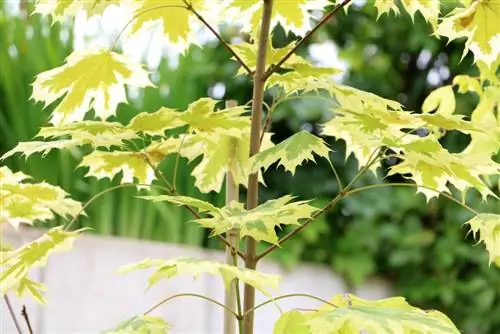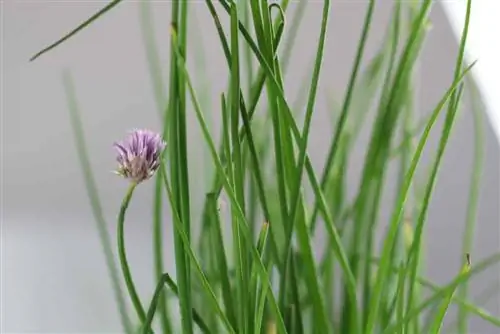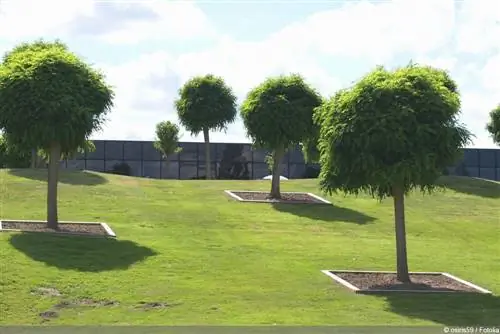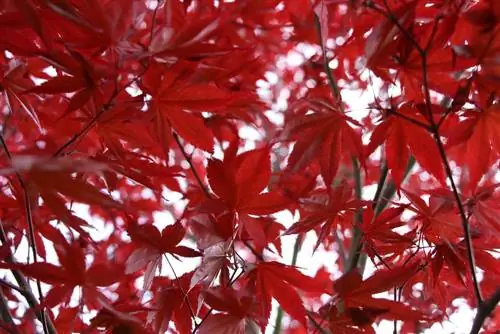- Author admin [email protected].
- Public 2023-12-17 03:39.
- Last modified 2025-06-01 06:48.
The entire genus of maple trees is sensitive to cutting. In this respect, the ball maple is no exception. The reason is the strong flow of sap during frost. If the tree loses a large part of its juices, it significantly loses its resistance to diseases and pests. Therefore, choose a time for pruning when the branches do not bleed or bleed little. Experience has shown that there is little or no sap flow from cuts when they are leafy.
When is the best time?
Late summer and autumn have proven to be the best time to prune a maple tree. At this time the juice pressure is at its lowest level. You can determine when the ideal date is with a test cut. Cut back two or three thinner branches and watch the sap flow. If the tree bleeds heavily, postpone pruning for a week and test again.
Why is regular pruning advisable?
We owe the decorative maple maple to a combination of skilful breeding and refinement. What is characteristic of an Acer platanoides 'Globosum' with a round crown is that its terminal buds at the end of the branches hardly sprout more strongly than the side buds. In contrast to the highly oval to pyramidal crowns of wild species, the hybrid impresses with a spherical crown.
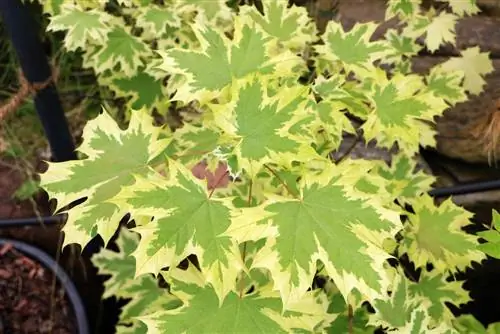
However, the spherical crown shape is only retained at a young age without any horticultural intervention. An older tree tends to grow wider and wider crowns, which are unflatteringly referred to as a 'pancake crown'. Given an annual growth of 20 to 40 cm, the undesirable development begins after just a few years. To counteract this tendency, a ball maple tree is subjected to a topiary cut every year.
So that the beautifully proportioned tree remains at the desired, low height of 300 to 400 cm, the crown is refined in the nursery to the straight, slender trunk of a robust wild species. Regular pruning is therefore not necessary to regulate height growth.
Cutting instructions for shape and maintenance cutting
The dreaded sap flow after pruning is reduced to a minimum if you prune your maple tree lightly every year. The extreme stress caused by a strong intervention is avoided, so that your ornamental tree remains beautiful and he althy. If the shape and maintenance pruning is based on these pruning instructions, you will enjoy your house tree for many years:
- Cut out dead branches from the crown in August/September
- Cut off or saw dead wood on a branch without leaving stubs
- Remove or shorten branches directed towards the interior of the crown
- Cut all branches around by a maximum of a third
- Place the scissors at a distance of 3-5 mm from a leaf or bud
Limit pruning to the area of the branches that you can cut off with regular secateurs. Experience has shown that a maple tolerates pruning in the thumb-thick branch area if it is done well in advance of the first frost. The saw should only be used to clear out dead wood.
Note:
Did you know that wound closure is no longer appropriate in professional incision care? Modern research has revealed that sealing cuts with tree wax counteracts the healing process. Only after a winter cut should the wound edges be lightly coated with tree paste to protect the sensitive cambium wood from frost.
Instructions for the correction cut
- Cutting ball maple after storm damage -
If a violent storm has affected the crown, just thin out the ball maple at first. Cut off the damaged branches without stubs just before the branch ring. It is important to note that you do not carry out the corrective pruning during frost because the severe loss of sap will bring the already stressed tree to its knees. If numerous branches have to be removed, the crown will become too light and uneven. Since the remaining shoots are susceptible to breakage, continue the measure according to the following cutting instructions:
- Shorten all branches around so that the harmonious spherical shape is restored
- Ideally limit the cut to the branch area as thick as your thumb
- Cut off dead branches that are directed towards the inside of the crown at the base
If you are forced to shorten thick branches, the tree will sprout heavily at this point. Remove the resulting excess branches in the following late summer by diverting a weaker shoot onto the stronger one at the branches. Of course, it can take some time until the original spherical crown has completely formed again.
Tip:
Nowhere does it say that a maple tree can be cut in a single day. Given the risk of sap loss, it therefore makes sense to spread a pruning measure over several dates in the fall. This prudence gives the maple tree time to regenerate its self-healing and defensive powers.
Cutting instructions for rejuvenation cut
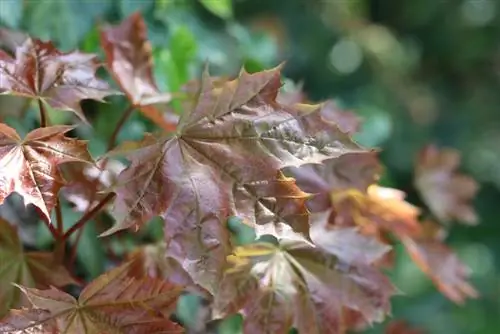
In an emergency, only radical pruning can prevent clearing. Common causes include extreme storm damage, fungal diseases, pest infestation or aging. The following instructions summarize what you should pay attention to when getting a rejuvenation cut:
Delicate choice of date
When you can carry out a rejuvenation cut is not only determined by the season and the current sap flow. Radical tree pruning of all kinds also requires compliance with the Federal Nature Conservation Act. To protect breeding birds, extensive cutting measures are prohibited by law between March 1st and September 30th. In order to meet the special requirements when cutting ball maple trees and at the same time act in accordance with the law, the time window is only open for a short time. Choose a date after September 30th and before the first frost, when the crown is ideally still wearing its foliage.
Cut above the finishing point
Please do not place the scissors or saw in the middle of the trunk. Such an incision ends all hopes of the automatic formation of a new spherical crown. Rather, only the wild rootstock will sprout and develop into a conventional maple with a broad oval or pyramidal crown. How to do it right:
- First thin out the damaged or aged crown thoroughly
- Short dead wood, sick, weak and too close branches up to the branch ring
- Cut back the remaining branches by up to two thirds
As long as at least one head with short shoots remains above the refinement of the crown, a new spherical crown can develop from it. As this development progresses, pruning is limited to annual thinning of branches that are too close together, weak and diseased. Once a satisfactory crown has formed, the autumn thinning is supplemented with a light topiary, as recommended in these instructions.
Annoying shoots on the trunk of the globe maple - what to do?
If the spherical crown sits on a particularly vigorous base, branches will sprout from the trunk and spoil the aesthetics. You can face this problem after just a year or after decades. The master gardener speaks here of wild shoots or blind shoots that have vital growth potential. Wild shoots compete with the noble variety for nutrients, water and access to light. Therefore, they strive to overgrow the crown above the grafting site. If this activity is not stopped, your ball maple tree will be fighting a losing battle because it cannot win this battle on its own. Use the following strategy to solve the problem:
Cancel is better than cutting off
If you have discovered a wild shoot in time, hold the branch in your hand and break it downwards at the base. This procedure removes much more tissue that can be divided than scissors. After a cut, the wound heals better, so that within a short time you will have to deal with even more wild shoots than before. In addition, increasingly thick bulges form as a result of the repeated overflowing of cambium wood after each cut.
Cut off older wild shoots
If you only notice a blind shoot after a year or more, breaking away causes considerable damage to the trunk bark. In these circumstances, cut or saw off the unwanted branch. Smooth the cut with a knife and dust it with charcoal ash. In the following period, please keep an eye on this trunk region like a hawk in order to break off young wild shoots in good time.
The right tool

The pronounced sensitivity to cutting of a ball maple requires special care when choosing tools. Smooth, vertical cuts ensure that sap can drain easily and the tree recovers quickly. Meticulous cleanliness ensures that no pathogens find their way into the tree via contaminated blades. We therefore recommend scissors based on the bypass system. These work with two sharp blades, whereas anvil scissors work with one sharp and one blunt side. The following tools and accessories are recommended for a smooth pruning:
- Garden shears for central topiary cutting in the maximum thumb-thick branch area
- Two-handed pruning shears or folding saw for removing dead wood
- Disinfectant or alcohol
- Cloth
- Work gloves
- Stable ladder
Clean blades and saw blades thoroughly before and after pruning. If your pruning work involves multiple trees, please clean the tool when moving from one maple tree to the next.

